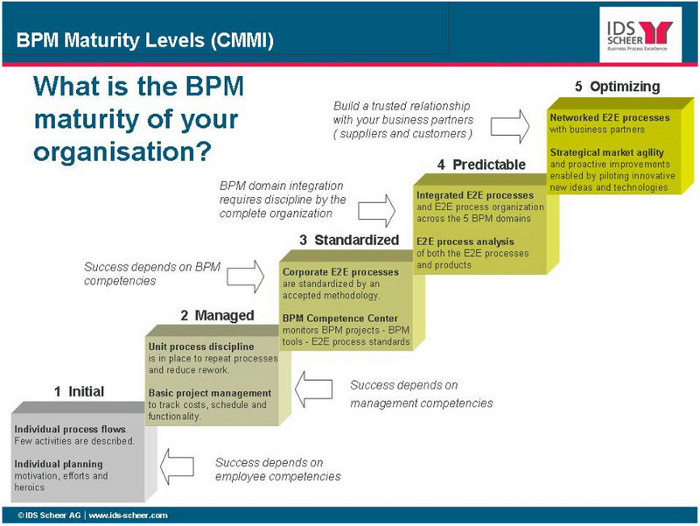Research studies (EFQM) and survey reports (McKinsey) towards the ROI of BPM show increased revenue with 35% and reduced costs with 30% and an agile organization which is able to quickly adapt to changed market situations. But how can you determine the actual BPM benefits for a specific company and at which BPM costs?
In part 1, the BPM framework is defined. This BPM framework contains 16 BPM process areas in which you will have BPM benefits and BPM costs when BPM (Business Process Management) is implemented. The current situation can be determined using the BPM maturity levels as defined by CMMI and more or less applied within BPM maturity models like OMG and EFQM. The generic principles of the CMMI maturity levels are as follows:
The higher the BPM maturity level (alignment) of the organization the more benefits the organization will gain by the formalization (level 1), harmonization (level 2), standardization (level 3), integration (level 4) and optimization (level 5) of Processes, Procedures, Policies, People, Planning, Production, Products, Projects, Platforms, Performance, ...
For every of the 16 process area’s there are (benchmark) reports available which indicate the BPM Benefits, the BPM projects and BPM tools required to reach (and stay on) the next BPM maturity level. Based on the principles of the enterprise BPM framework and the principles of the BPM maturity levels, it is possible to create a standard set of BPM maturity questions and a predefined BPM ROI calculation model for each BPM process area.
The BPM Business value is not determined by the sophistication of the technology but it is determined by the contribution towards a higher maturity level and by the value it delivers to the business objectives of the BPM stakeholders. Every BPM process area has a different BPM stakeholder with different business objectives. For every process area of the BPM framework a BPM stakeholder can be determined. An example of the BPM stakeholders is the following:
The cost of BPM is determined by the BPM projects and the BPM tools which are required to reach the next BPM maturity level. The BPM tools should be utilized to ensure that the organization stays on the next maturity level to make sure that the BPM benefits can be capitalized every year.
When the BPM business benefits case is validated by the BPM stakeholders, the ROI of BPM becomes clearer to the organization and the BPM roadmap will get more support from the business. In my next blog post, I will elaborate on the BPM projects and BPM tools which are required to reach the next BPM maturity level.
More information can be found at:http://www.lulu.com/shop/frank-luyckx/enterprise-bpm-roadmap-assessments/paperback/product-20265487.html




Site Administrator on
Right so rather than doing BPM we now first have to do a custom BPM methodology. We go one more level abstract so that we need to decompose one level deeper to get something productive.
If you excuse my directness, but this is utterly unaffordable and unproductive and is not needed at all to run a business eficiently. You cant replace people with a flowcharted business machine ….